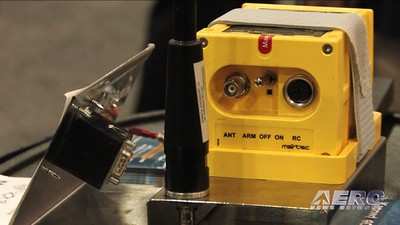Mon, Jun 21, 2010
Implementation Date For The Ban Is Still Not Set In Stone
Effective in August, the FCC is prohibiting further
certification, manufacture, importation, sale or use of 121.5 MHz
emergency locator transmitters. The date of compliance by the FCC
has not yet been announced. AEA, along with other
Associations' leadership, is working with the FAA and the FCC to
postpone implementation and resolve this issue, and AEA says it
will post weekly updates on the website to address this critical
issue.

406 MHz ELT File Photo
In the FCC's Third Report and Order for
2010, adopted June 1, 2010, and published June 15, 2010, the FCC
has prohibited further certification, manufacture, importation,
sale or use of 121.5 MHz ELTs.
Previously, the Cospas-Sarsat satellite system monitored distress
signals on the 121.5 MHz frequency and relayed those signals to
search-and-rescue authorities. As it first announced in October
2000, Cospas-Sarsat stopped monitoring 121.5 MHz signals as of Feb.
1, 2009. It stopped processing distress signals from 121.5 MHz
emergency radio beacons because of accuracy and false-alert
problems. With the support of international aviation and maritime
organizations, Cospas-Sarsat has urged users of 121.5 MHz ELTs and
EPIRBs to switch to 406 MHz ELTs and emergency position indicating
radio beacons.
As the commission noted in the second FNPRM, NOAA, the U.S. Coast
Guard, the U.S. Air Force, and NASA, which jointly administer the
Cospas-Sarsat system in the United States, strongly recommended
users of 121.5 MHz beacons switch to 406 MHz beacons.
After reviewing the comments from the 2006 proposal, the FCC
concluded it should go ahead with the ban.

The AEA was not made aware of this
issue until Monday, June 21st, and has begun working with the FAA,
FCC and other associations to allow for a timely transition to this
new FCC prohibition without grounding thousands of general aviation
aircraft. At this time, the AEA recommends members delay selling
any new 121.5 MHz ELTs until further understanding of this new
prohibition can be understood and a realistic timeline for
transition can be established.
More News
“...no entity, whether a division of government or a private company or corporation, may use information broadcast or collected by automatic dependent surveillance-broadcast >[...]
Growth And Fleet Replacements On The Way International Airlines Group, a joint holding company between British and Spanish air carriers, announced it has ordered up to 76 new Boein>[...]
Expert Analysts Scrutinized the FAA’s Oversight of ATC Organization In a move that appears somewhat mistimed (at best…tone-deaf at worst), the Federal Aviation Adminis>[...]
Community Continues to Push Back Against ADS-B-Facilitated Landing Fees On May 8, a bill to limit frivolous use of ADS-B tracking data was signed into law by Montana Governor Greg >[...]
Duffy Shares Plans to Scale Back Flights at Newark Liberty International After a ‘telecommunications issue’ with Philadelphia TRACON brought yet another string of delay>[...]
 Aero-News: Quote of the Day (05.13.25)
Aero-News: Quote of the Day (05.13.25) IAG Orders 76 Boeing, Airbus Airliners
IAG Orders 76 Boeing, Airbus Airliners FAA Shuts Down ATC Oversight Review Amid Scrutiny
FAA Shuts Down ATC Oversight Review Amid Scrutiny Montanas ADS-B Privacy Bill Signed Into Law
Montanas ADS-B Privacy Bill Signed Into Law Newark Falls Victim to More Equipment Outages
Newark Falls Victim to More Equipment Outages




